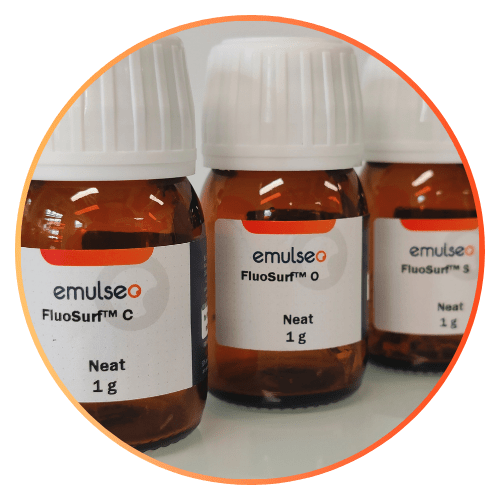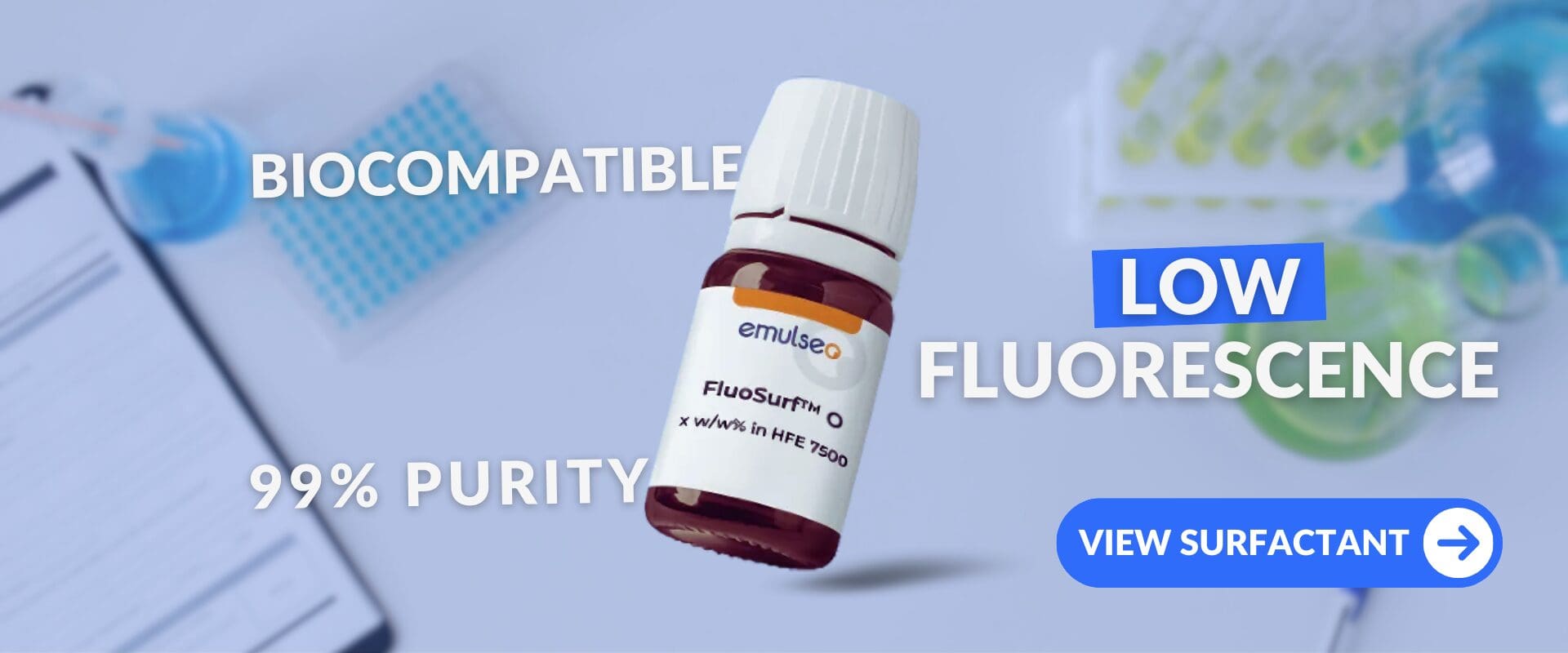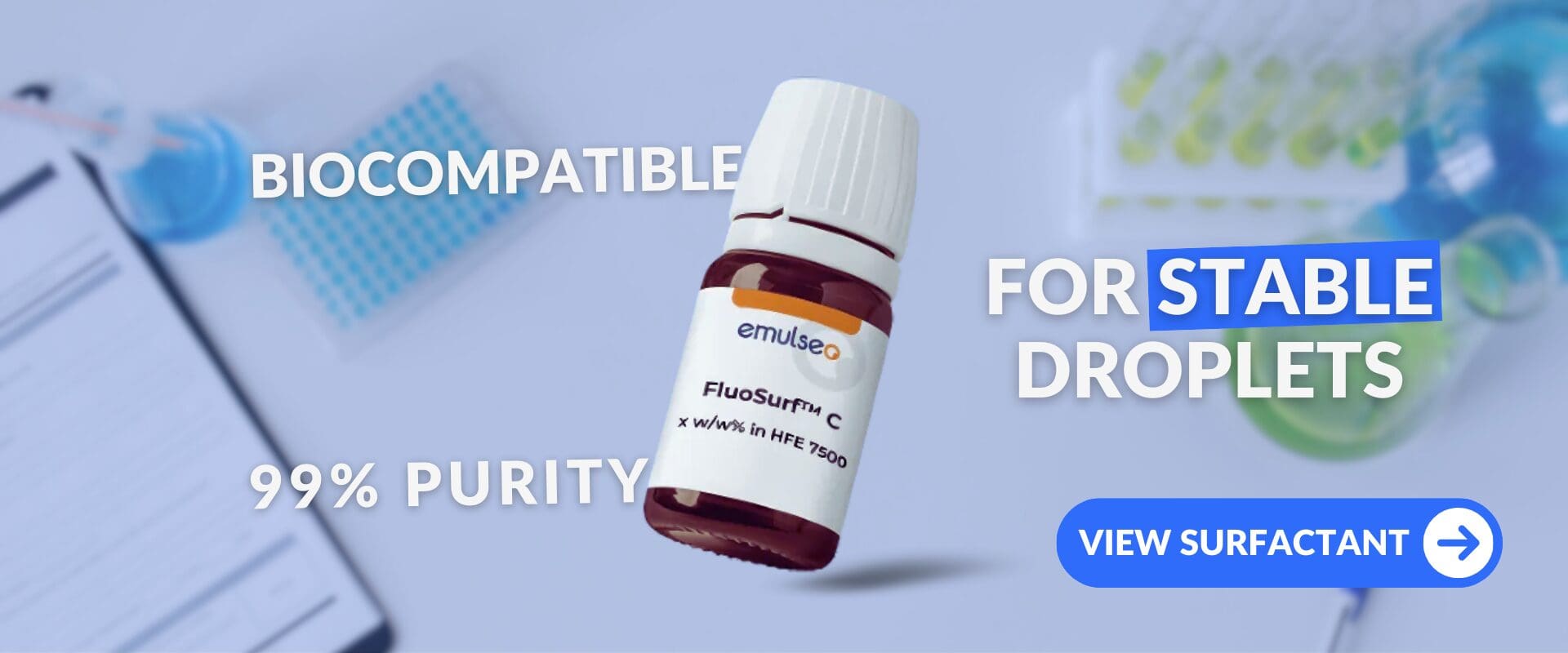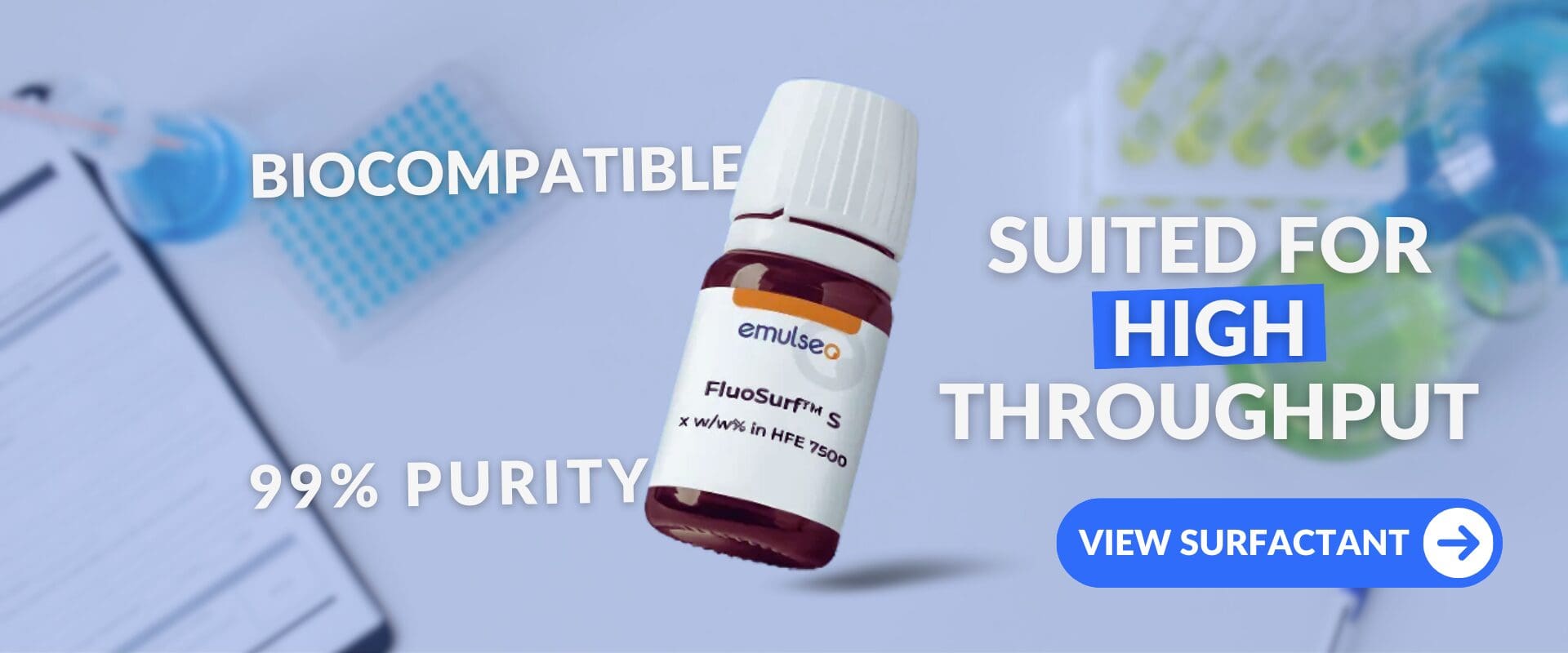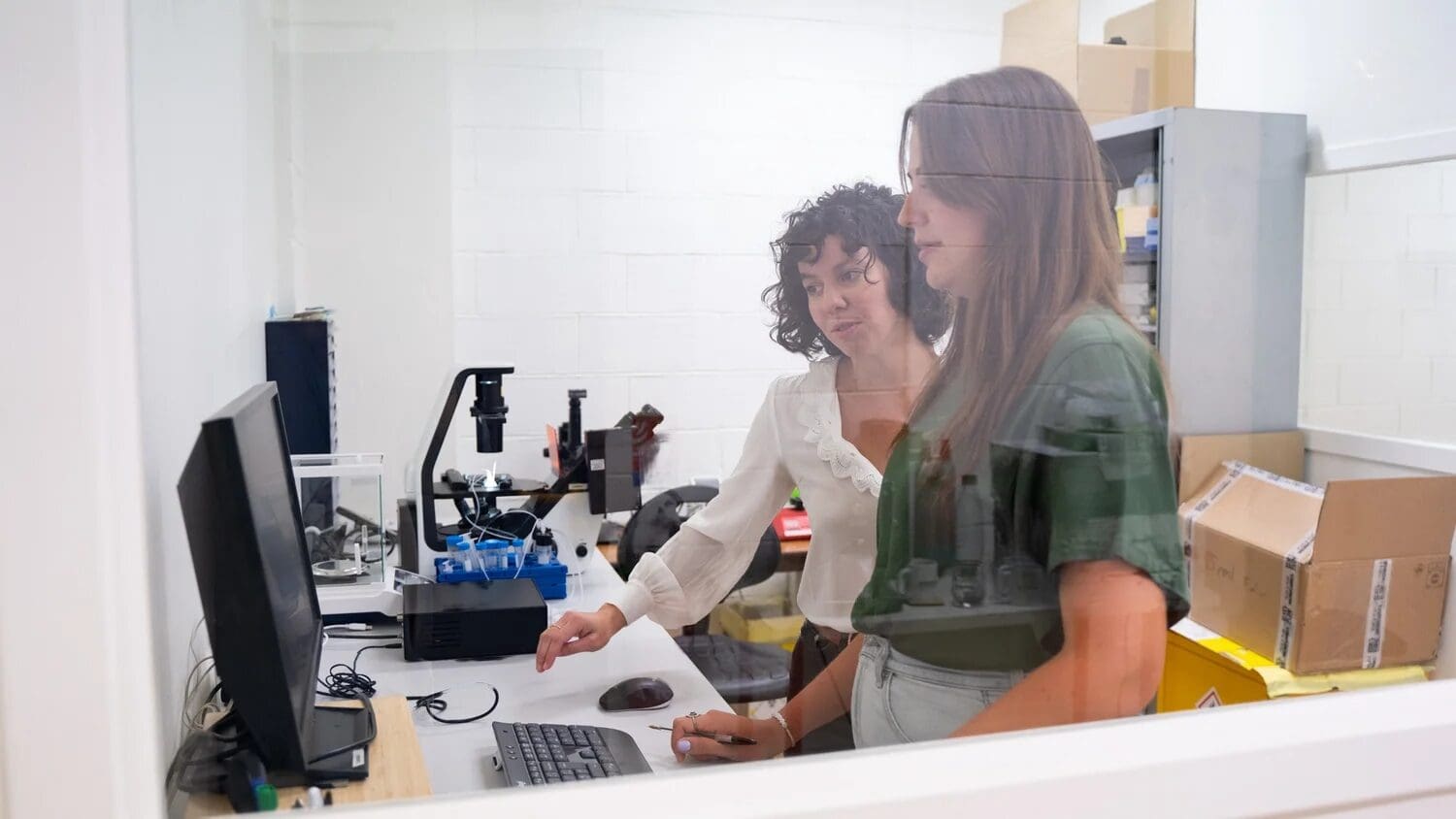Surfactants are essential in microfluidic droplet generation, where precise control over droplet formation and stability is crucial. By reducing interfacial tension and stabilizing emulsions, surfactants enable the production of uniform droplets, making them indispensable in industries such as pharmaceuticals, cosmetics, biotechnology, and food.
In this blog, we will explore some of the most commonly used surfactants for microfluidic droplet generation and highlight the advantages of FluoSurf™, high-performance surfactants from Emulseo.
Overview of Common Surfactants for Droplet Generation
Selecting the right surfactant is key to achieving stable and uniform droplet formation in microfluidics. Depending on the emulsion type, different surfactants are used to stabilize either oil-in-water (O/W) or water-in-oil (W/O) systems.
- O/W emulsifiers help disperse oil droplets in a continuous water phase. These are typically hydrophilic surfactants with a high HLB (Hydrophilic-Lipophilic Balance) value.
- W/O emulsifiers stabilize water droplets in an oil phase, requiring more lipophilic surfactants with a lower HLB value.
The following subsections will outline some of the most commonly used surfactants for both O/W and W/O emulsification in microfluidic droplet generation.
Common Surfactants for Oil-in-Water Droplet Formation
In O/W emulsions, the continuous phase is water, while the dispersed phase is oil. Therefore, these emulsions require hydrophilic surfactants with a high Hydrophilic-Lipophilic Balance (HLB) (typically above 8 or 9) to effectively stabilize the droplets and prevent coalescence. Stabilization occurs through electrostatic repulsion (charged surfactants) or steric hindrance (nonionic surfactants), depending on the formulation. Many O/W surfactants are biocompatible, making them suitable for pharmaceutical and biological applications.
Common surfactants used for O/W emulsions include:
- Tween 20 (Polysorbate 20) – A widely used nonionic surfactant known for its biocompatibility and effectiveness in stabilizing emulsions, commonly used in biological assays, drug delivery, and food emulsions.
- Tween 80 (Polysorbate 80) – Similar to Tween 20 but with higher hydrophobicity, making it suitable for emulsifying a broader range of oils, frequently employed in pharmaceutical formulations and cosmetics.
- Sodium Dodecyl Sulfate (SDS) – An anionic surfactant that provides strong electrostatic stabilization, preventing droplet coalescence, widely used in protein solubilization, and DNA/RNA extraction.
- Pluronic F-68 – A nonionic triblock copolymer surfactant commonly used in biological and pharmaceutical applications, including cell culture media and drug delivery.
- CTAB (Cetyltrimethylammonium Bromide) – A cationic surfactant used in specialized applications requiring controlled surface charges, often used in nanoparticle synthesis, DNA extraction, and antimicrobial formulations.
Common Surfactants for Water-in-Oil Droplet Formation
In W/O emulsions, the continuous phase is oil, while the dispersed phase consists of aqueous droplets. These emulsions require lipophilic surfactants with a low Hydrophilic-Lipophilic Balance (HLB) (typically below 7) to stabilize the water droplets and prevent coalescence. Stabilization mechanisms vary, with nonionic surfactants providing steric hindrance and specialized fluorinated surfactants offering enhanced droplet control.
Common surfactants used for W/O emulsions include:
- Span 80 (Sorbitan Monooleate) – A widely used nonionic surfactant known for its efficiency in stabilizing water droplets in oil, commonly applied in food emulsions and pharmaceutical formulations.
- Other Sorbitan Esters (e.g., Span 60, Span 85 …) – A group of surfactants with excellent emulsification properties, widely used in cosmetics, pharmaceuticals, and industrial applications.
- PGPR (Polyglycerol Polyricinoleate–E476) – Frequently employed in food and pharmaceutical industries, particularly in chocolate production and drug delivery systems.
💡 In some applications, combining multiple surfactants can enhance droplet stability and performance. By carefully selecting and blending surfactants with complementary properties—such as a nonionic surfactant for steric stabilization and an ionic surfactant for electrostatic repulsion—it is possible to fine-tune the emulsion’s stability, droplet size, and interfacial properties to meet specific experimental needs.
Selecting the appropriate surfactant is key to ensuring stable and efficient droplet generation. The tool below provides a simple way to identify suitable surfactants based on the emulsion type (O/W or W/O) while displaying key physico-chemical properties such as Critical Micelle Concentration (CMC), Hydrophilic-Lipophilic Balance (HLB), and Molecular Weight. It serves as a quick reference to support microfluidic applications requiring precise surfactant selection.
🚨 The Hydrophilic-Lipophilic Balance (HLB) system traditionally ranges from 0 to 20, but some surfactants exceed 20 due to alternative calculation methods or extreme hydrophilicity. Highly water-soluble surfactants, especially ionic ones, may be assigned higher HLB values to better classify their emulsification properties. While the standard HLB scale remains widely used, these extended values help differentiate highly hydrophilic surfactants.
Emulseo's FluoSurf
FluoSurf™ surfactants are advanced fluorinated nonionic surfactants specifically formulated to stabilize aqueous droplets in fluorinated oils (W/O) for chemical and biotechnological applications. Developed by Emulseo, these high-performance surfactants are particularly suited for droplet-based microfluidic experiments, including droplet digital PCR (ddPCR) and single-cell analysis.
With exceptional stability, biocompatibility, and purity, FluoSurf surfactants ensure reliable droplet generation while minimizing leakage and maintaining consistency across experiments. Their scalable production and strict quality control guarantee reproducibility, making them an ideal choice for researchers and industries requiring precision and efficiency in microfluidic workflows.
Each FluoSurf variant is designed for specific applications while maintaining the core benefits of high monodispersity, droplet stability, and biocompatibility. Below, we explore the different FluoSurf surfactants offered by Emulseo, highlighting their physico-chemical properties and applications.
FluoSurf™ - Neat
Neat FluoSurf™ is the pure, undiluted form of FluoSurf, allowing researchers to fine-tune surfactant concentrations to their specific experimental needs. Before use, it should be diluted in a fluorinated oil—such as Emulseo’s Fluo-Oil 7500 or Fluo-Oil 40—and left overnight to ensure optimal performance. For added convenience, it is also available as a pre-diluted, ready-to-use formulation at the desired concentration.
FluoSurf-C™
FluoSurf-C™ is a high-performance fluorinated surfactant optimized for stabilizing aqueous droplets in fluorinated oils. It is ideal for microfluidic applications, including droplet digital PCR (ddPCR) and single-cell analysis, ensuring stable, reproducible droplet formation. With the same trusted formulation as the original FluoSurf™, it offers reliable performance for a variety of chemical and biotechnological applications.
FluoSurf-O™
FluoSurf-O™ is designed for fluorescence-based applications where minimal background signal is essential. It retains all the benefits of FluoSurf-C™ while offering ultra-low autofluorescence, making it particularly suited for experiments requiring precise optical detection at low dye concentrations.
FluoSurf-S™
FluoSurf-S™ is engineered for demanding applications requiring high-frequency droplet generation and stability under extreme conditions, such as thermocycling in ddPCR. Its lower molecular weight enhances compatibility with viscous aqueous solutions. However, it is not recommended for use with dyes due to potential cross-contamination.
To provide a clearer understanding of the key characteristics that influence the performance of FluoSurf™ surfactants, a table summarizing important physico-chemical properties is presented below.
| Surfactant | FluoSurf™ | FluoSurf-C™ | FluoSurf-O™ | FluoSurf-S™ |
|---|---|---|---|---|
| CMC in HFE 7500 (w/w%) | 0.03 | 0.2 | 0.2 | 0.03 |
| HLB value | 3.9 | 1.5 | 1.5 | 3.9 |
| Molecular Weight (kg/mol) | 7-13 | 7-13 | 7-13 | 3-5 |
| Interfacial tension at 4wt% in HFE 7500 (mN/m) | 4 | 10 | 10 | 4 |
💡 FluoSurf™ surfactants must be properly diluted in Emulseo’s Fluo-Oil 7500, Fluo-Oil 40, Fluo-Oil 200, or Fluo-Oil 135 before use. For convenience, these surfactants can also be supplied pre-diluted at the desired concentration.
Which FluoSurf™ Surfactant is Best for Your Application?
FluoSurf™ surfactants are designed to support a wide range of microfluidic applications, offering exceptional stability, biocompatibility, and purity. They are ideal for water-in-oil droplet generation, single-cell analysis, cell sorting, encapsulation, and PCR-based techniques. Additionally, FluoSurf™ surfactants stabilize droplets used for the formation of alginate, polyacrylate, agarose, and epoxy beads, as well as for 3D cell culture applications. Whether for fundamental research or advanced biotechnological processes, they ensure reliable performance and reproducibility across diverse experimental workflows.
The tables below present the suitability of FluoSurf™ surfactants for various applications, based on their specific formulations—each referring to a FluoSurf™ variant (C, O, or S) diluted in different Emulseo Fluo-Oil solvents (Fluo-Oil 40, Fluo-Oil 135, Fluo-Oil 200, or Fluo-Oil 7500). These formulations determine the surfactant’s performance across different applications.
💡 The ratings—A, B, C, and D—help identify the most suitable formulation, where:
- A denotes the top recommendation,
- B indicates strong suitability,
- C suggests acceptable but suboptimal performance,
- D signifies that the formulation is not recommended for that application.
Oil of Dilution Application | Fluo-Oil 40 | Fluo-Oil 135 | Fluo-Oil 200 | Fluo-Oil 7500 |
|---|---|---|---|---|
| ddPCR (30 PCR cycles) | D | A | D | A |
| ddPCR (40 PCR cycles) | D | D | D | D |
| Encapsulation of small dyes / leakage issues | A | B | A | C |
| Fluorescence measurements | C | C | C | C |
Oil of Dilution Application | Fluo-Oil 40 | Fluo-Oil 135 | Fluo-Oil 200 | Fluo-Oil 7500 |
|---|---|---|---|---|
| ddPCR (30 PCR cycles) | D | A | D | A |
| ddPCR (40 PCR cycles) | D | D | D | D |
| Encapsulation of small dyes / leakage issues | A | B | A | C |
| Fluorescence measurements | A | A | A | A |
Oil of Dilution Application | Fluo-Oil 40 | Fluo-Oil 135 | Fluo-Oil 200 | Fluo-Oil 7500 |
|---|---|---|---|---|
| ddPCR (30 PCR cycles) | D | A | D | A |
| ddPCR (40 PCR cycles) | D | A | D | A |
| Encapsulation of small dyes / leakage issues | D | D | D | D |
| Fluorescence measurements | B | B | B | B |
💡 Conclusion
Surfactants play a crucial role in microfluidic droplet generation, ensuring droplet stability, precision, and reproducibility across a wide range of applications. Choosing the right surfactant depends on the specific emulsion type, experimental conditions, and desired performance characteristics. A thorough understanding of surfactant properties enables researchers to optimize their workflows, whether for biological assays, material synthesis, or advanced lab-on-a-chip technologies.
Stay tuned for more insights into microfluidic innovations, and practical solutions for enhancing droplet-based experiments. Until then, don’t pop your drop 🫧!
📧 If you have any questions or feedback, please feel free to contact us at contact@darwin-microfluidics.com.
